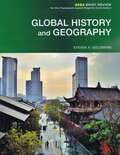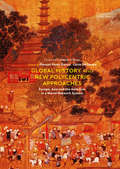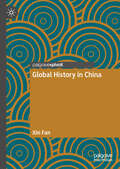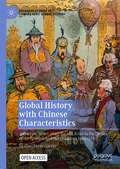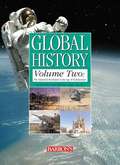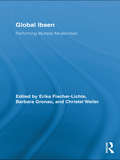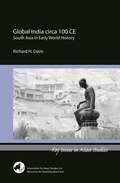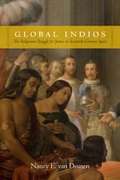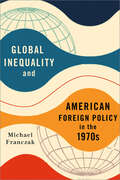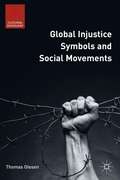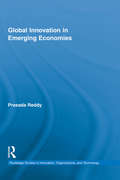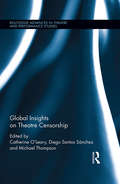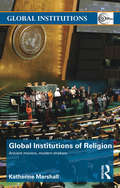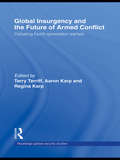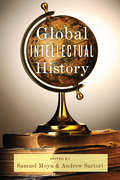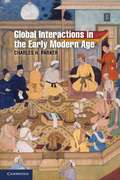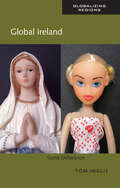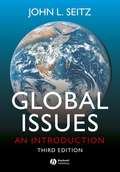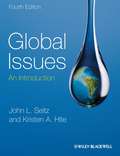- Table View
- List View
Global History and Geography: 2020 Brief Review for the Framework-based Regents Examination
by Steven A. GoldbergThis book has been written to help the students review the Global History and Geography Course. The features are: Detailed content review of key concepts and skills, Information on recent global events and international policies, Document-based question practice, Questions for Regents Practice, Strategies and skills the students will need to apply their social studies knowledge to the Regents Examination.
Global History and Geography: The Growth of Civilizations (2nd Edition)
by Herbert Brodsky Lillian Forman Henry BrunThis book provides study materials for students taking the 9th-10th grade New York State Global History and Geography course and Regents Examination, as well as others taking a similar course in Global History, with a comprehensive, one-volume text.
Global History and New Polycentric Approaches: Europe, Asia and the Americas in a World Network System (Palgrave Studies in Comparative Global History)
by Manuel Perez Garcia Lucio De SousaThis book is open access under a CC BY 4. 0 license. Rethinking the ways global history is envisioned and conceptualized in diverse countries such as China, Japan, Mexico or Spain, this collections considers how global issues are connected with our local and national communities. It examines how the discipline had evolved in various historiographies, from Anglo Saxon to southern European, and its emergence in Asia with the rapid development of the Chinese economy motivation to legitimate the current uniqueness of the history and economy of the nation. It contributes to the revitalization of the field of global history in Chinese historiography, which have been dominated by national narratives and promotes a debate to open new venues in which important features such as scholarly mobility, diversity and internationalization are firmly rooted, putting aside national specificities. Dealing with new approaches on the use of empirical data by framing the proper questions and hypotheses and connecting western and eastern sources, this text opens a new forum of discussion on how global history has penetrated in western and eastern historiographies, moving the pivotal axis of analysis from national perspectives to open new venues of global history.
Global History in China
by Xin FanThis book explores global history as an emerging field of scholarly studies in China today. Readers are invited to rethink the origin of global history in China and to examine its current state. Chinese scholarship is rooted in a warm appreciation of globalization in the age of Opening-up and Reform and presented as a trendy transnational intellectual movement at the opening of the twenty-first century. On the one hand, global history claims an identity of the “new” eager to criticize the Eurocentric bias embedded in the narratives of the “old,” ones from world history; on the other hand, as an emerging field, it is yet to face competitions from national histories and area studies, which are nurtured by latest state initiatives with outspoken political agendas. As a whole, global history captures Chinese scholars’ tenacious interest in studying globalization through the lens of history. This book will interest historians, China scholars, and those trying to grasp the “Chinese perspective” on the world.
Global History with Chinese Characteristics: Autocratic States along the Silk Road in the Decline of the Spanish and Qing Empires 1680-1796 (Palgrave Studies in Comparative Global History)
by Manuel Perez-GarciaThis open access book considers a pivotal era in Chinese history from a global perspective. This book’s insight into Chinese and international history offers timely and challenging perspectives on initiatives like “Chinese characteristics”, “The New Silk Road” and “One Belt, One Road” in broad historical context. Global History with Chinese Characteristics analyses the feeble state capacity of Qing China questioning the so-called “High Qing” (shèng qīng 盛清) era’s economic prosperity as the political system was set into a “power paradox” or “supremacy dilemma”. This is a new thesis introduced by the author demonstrating that interventionist states entail weak governance. Macao and Marseille as a new case study aims to compare Mediterranean and South China markets to provide new insights into both modern eras’ rising trade networks, non-official institutions and interventionist impulses of autocratic states such as China’s Qing and Spain’s Bourbon empires.
Global History, Volume Two: The Industrial Revolution to the Age of Globalization
by Mark Willner Jerry Weiner George HeroThis book is designed to be used as the second volume of a basic two-volume high school text for a two-year, four-term study of the world--its history and its people. It can also be used in a one-year, two-term study. The material is presented in a manner that is appropriate for an introductory survey course. This volume covers the regions of Africa, Asia, Europe, and Latin America, from the early nineteenth century to the beginning of the twenty-first century.
Global Ibsen: Performing Multiple Modernities (Routledge Advances in Theatre & Performance Studies)
by Erika Fischer-LichteIbsen’s plays rank among those most frequently performed world-wide, rivaled only by Brecht, Chekhov, Shakespeare, and the Greek tragedies. By the time Ibsen died in 1906, his plays had already conquered the theaters of the Western world. Inviting rapturous praise as well as fierce controversy, they were performed in Europe, North America, and Australia, contributing greatly to the theater, culture, and social life of these continents. Soon after Ibsen’s death, his plays entered the stages of East Asia - Japan, China, Korea - as well as Africa and Latin America. . But while there exist countless studies on Ibsen the dramatist and the significance of his plays within different cultures written mainly by literary scholars, none of them examine the ways in which Ibsen's plays were performed, or the impact of such performances on the theater, social life, and politics of these cultures. In Global Ibsen, contributors look at the way performances of Ibsen's plays address problems typical to modern societies all over the world, including: the inferior social status of women, the decay of bourgeois family life and values, religious fundamentalism, industrial pollution and corporate cover-up, and/or the loss of and search for identity.
Global Imbalances and the Lessons of Bretton Woods (Cairoli Lectures)
by Barry EichengreenWhy the current Bretton Woods-like international financial system, featuring large current account deficits in the center country, the United States, and massive reserve accumulation by the periphery, is not sustainable. In Global Imbalances and the Lessons of Bretton Woods, Barry Eichengreen takes issue with the argument that today's international financial system is largely analogous to the Bretton Woods System of the period 1958 to 1973. Then, as now, it has been argued, the United States ran balance of payment deficits, provided international reserves to other countries, and acted as export market of last resort for the rest of the world. Then, as now, the story continues, other countries were reluctant to revalue their currencies for fear of seeing their export-led growth slow and suffering capital losses on their foreign reserves. Eichengreen argues in response that the power of historical analogy lies not just in finding parallels but in highlighting differences, and he finds important differences in the structure of the world economy today. Such differences, he concludes, mean that the current constellation of exchange rates and payments imbalances is unlikely to last as long as the original Bretton Woods System. Two of the most salient differences are the twin deficits and low savings rate of the United States, which do not augur well for the sustainability of the country's international position. Such differences, he concludes, mean that the current constellation of exchange rates and payments imbalances is unlikely to last as long as the original Bretton Woods System. After identifying these differences, Eichengreen looks in detail at the Gold Pool, the mechanism through which European central banks sought to support the dollar in the 1960s. He shows that the Pool was fragile and short lived, which does not bode well for collective efforts on the part of Asian central banks to restrain reserve diversification and support the dollar today. He studies Japan's exit from its dollar peg in 1971, drawing lessons for China's transition to greater exchange rate flexibility. And he considers the history of reserve currency competition, asking if it has lessons for whether the dollar is destined to lose its standing as preeminent international currency to the euro or even the Chinese renminbi.
Global India circa 100 CE (Key Issues in Asian Studies)
by Richard H. DavisBy focusing on traders, missionaries, warriors, and adventurers—the four types of agents who are responsible for globalizing processes— this highly accessible volume brings analytical coherence and clarity to an unwieldy subject matter. In addition to excellent coverage of more familiar topics such as India’s sea trade with Rome, the proselytizing efforts of Ashoka and other Indian kings, or the migration of the Yueh-chih people, Davis adds valuable analyses of story literature, the Ramayana epic, and Buddhist art. Global India circa 100 CE is an entertaining introduction to India’s international interactions and conceptions that will greatly benefit teachers and students of world history as well as ancient Asia.
Global Indios: The Indigenous Struggle for Justice in Sixteenth-Century Spain
by Nancy E. van DeusenIn the sixteenth century hundreds of thousands of indios--indigenous peoples from the territories of the Spanish empire--were enslaved and relocated throughout the Iberian world. Although various laws and decrees outlawed indio enslavement, several loopholes allowed the practice to continue. In Global Indios Nancy E. van Deusen documents the more than one hundred lawsuits between 1530 and 1585 that indio slaves living in Castile brought to the Spanish courts to secure their freedom. Because plaintiffs had to prove their indio-ness in a Spanish imperial context, these lawsuits reveal the difficulties of determining who was an indio and who was not--especially since it was an all-encompassing construct connoting subservience and political personhood and at times could refer to people from Mexico, Peru, or South or East Asia. Van Deusen demonstrates that the categories of free and slave were often not easily defined, and she forces a rethinking of the meaning of indio in ways that emphasize the need to situate colonial Spanish American indigenous subjects in a global context.
Global Inequality and American Foreign Policy in the 1970s
by Michael FranczakIn Global Inequality and American Foreign Policy in the 1970s, Michael Franczak demonstrates how Third World solidarity around the New International Economic Order (NIEO) forced US presidents from Richard Nixon to Ronald Reagan to consolidate American hegemony over an international economic order under attack abroad and lacking support at home. The goal of the nations that supported NIEO was to negotiate a redistribution of money and power from the global North to the global South. Their weapon was control over the major commodities—in particular oil—that undergirded the prosperity of the United States and Europe after World War II.Using newly available archival sources, as well as interviews with key administration officials, Franczak reveals how the NIEO and "North-South dialogue" negotiations brought global inequality to the forefront of US national security. The challenges posed by NIEO became an inflection point for some of the greatest economic, political, and moral crises of 1970s America, including the end of golden age liberalism and the return of the market, the splintering of the Democratic Party and the building of the Reagan coalition, and the rise of human rights in US foreign policy in the wake of the Vietnam War. The policy debates and decisions toward the NIEO were pivotal moments in the histories of three ideological trends—neoliberalism, neoconservatism, and human rights—that formed the core of America's post–Cold War foreign policy.
Global Inequality: A New Approach for the Age of Globalization
by Branko MilanovicBranko Milanovic presents a bold account of the dynamics that drive inequality on a global scale. Using vast data sets, he explains the forces that make inequality rise and fall within and among nations over time. He reveals who has been helped by globalization, who has been hurt, andwhat policies might tilt the balance toward economic justice.
Global Injustice Symbols and Social Movements
by Thomas OlesenGlobal Injustice Symbols and Social Movements theorizes how transnational social movements create symbols of injustice in order to foster and sustain the solidarity necessary for their success. Olesen examines our collective moral and political maps, dotted with symbols shaped by political dynamics beyond their local or national origin, and offers the first systematic sociological treatment of this important phenomenon. Using empirical data collected from media archives, official documents,and internet sources, Olesen seeks to answer how global injustice symbols are formed, how they are employed by political actors, and to what ends.
Global Innovation in Emerging Economies (Routledge Studies in Innovation, Organizations and Technology)
by Prasada ReddyIn recent decades, there have been significant changes in the way corporate innovation activities are performed. They include changes in the innovation process, flexibility to outsource certain innovation activities, and by far, the most important one, wider choice in the location of innovation. What caught the most attention of is the trend towards globalization of research and development (R&D) and thereby performance of innovation activities away from the home countries. The main concerns relate to the two new trends: First, the multinational corporations (MNCs) locating strategic innovation activities in some countries outside the industrialized world, which can be referred to as ‘emerging economies’; and Second, since 2000, some companies from the emerging economies have started entering the global markets with innovative products and services, developed through their own R&D. Both these new developments have managerial implications for companies and policy implications for the host countries (where such R&D is performed), as well as for the home countries of the companies. Further, innovative products and services resulting from R&D activities in emerging economies seem to better address the needs of consumers at the bottom-of-the-pyramid in other developing countries. This book explores and analyzes these issues. This research presented in Global Innovation in Emerging Economies is applicable to both the industrialized and developing worlds, although from different perspectives – the former would like to prevent relocation of R&D from their countries, and the latter want more of R&D-related investments.
Global Insights on Theatre Censorship (Routledge Advances in Theatre & Performance Studies)
by Michael Thompson Diego Santos Sánchez Catherine O'LearyTheatre has always been subject to a wide range of social, political, moral, and doctrinal controls, with authorities and social groups imposing constraints on scripts, venues, staging, acting, and reception. Focusing on a range of countries and political regimes, this book examines the many forms that theatre censorship has taken in the 20th century and continues to take in the 21st, arguing that it remains a live issue in the contemporary world. The book re-examines assumptions about prohibition and state control, and offers a more complex reading of theatre censorship as a continuum ranging from the unconscious self-censorship built into social structures and discursive practices, through bureaucratic regulation or unofficial influence, up to detention and physical violence. An international team of contributors offers an illuminating set of case studies informed by both new archival research and the first-hand experience of playwrights and directors, covering theatre censorship in areas such as Spain, Portugal, Brazil, Poland, East Germany, Nepal, Zimbabwe, the USA, Ireland, and Britain. Focusing on right-wing dictatorships, post-colonial regimes, communist systems and Western democracies, the essays analyze methods and discourses of censorship, identify the multiple agents involved, examine the responses of theatremakers, and show how each example reveals important features of its political and cultural contexts. Expanding understanding of the nature and effects of censorship, this volume affirms the power of theatre to challenge authorized discourses and makes a timely contribution to debates about freedom of expression through performance.
Global Insights: People & Cultures
by Mounir A. Farah Et Al Thomas O. FlickemaThe intent of Global Insights is to provide global knowledge and understanding by having the peoples of eight different geographical regions speak for themselves about the elements that have shaped their lives and made them the way they are today. The text is divided into eight units--Africa, China, Japan, India, Latin America, the Middle East, the Commonwealth of Independent States, and Europe.
Global Institutions of Religion: Ancient Movers, Modern Shakers (Global Institutions)
by Katherine MarshallThis work fills a significant gap in the current literature by providing a concise introduction to religious institutions and an insightful analysis of their role in world affairs. Focusing on formal institutions specifically dedicated to governing religious communities, the work examines the intersections between religious and other global institutions, set against the fundamental question: why and how do these intersections matter? The work explores the role of religion within key issues including Human rights Human security International development and humanitarian relief Climate change Moral responsibilities The new forms that religious institutions are taking, their fit with human rights and democratic ideals, their changing nature in plural societies, are a highly relevant part of the global institutional picture and this book is essential reading for all students and scholars of global institutions, international relations and religion.
Global Insurgency and the Future of Armed Conflict: Debating Fourth-Generation Warfare (Routledge Global Security Studies)
by Terry TerriffThis volume covers a timely debate in contemporary security studies: can armed forces adjust to the rising challenge of insurgency and terrorism, the greatest transformation in warfare since the birth of the international system? Containing essays by leading international security scholars and military professionals, it explores the Fourth-Generation Warfare thesis and its implications for security planning in the twenty-first century. No longer confined to the fringes of armed conflict, guerrilla warfare and terrorism increasingly dominate world-wide military planning. For the first time since the Vietnam War ended, the problems of insurgency have leapt to the top of the international security agenda and virtually all countries are struggling to protect themselves against terrorist threats. Coalition forces in Afghanistan and Iraq are bogged down by an insurgency, and are being forced to rely on old warfare tactics rather than modern technologies to destroy their adversaries. These theorists argue that irregular warfare—insurgencies and terrorism—has evolved over time and become progressively more sophisticated and difficult to defeat as it is not centred on high technology and state of the art weaponry. Global Insurgency and the Future of Armed Conflict will be of interest to students of international security, strategic studies and terrorism studies.
Global Intellectual History
by Samuel Moyn Andrew SartoriWhere do ideas fit in historical accounts that take an expansive, global view of human movements and events? Teaching intellectual history scholars to incorporate transnational perspectives into their work, while also advising them how to handle the challenges and controversies that may arise, this original resource explains the concepts, practice, concerns, and promise of “global intellectual history,” featuring essays from leading scholars on an array of approaches taking shape across the discipline. Contributors explore the different ways one can think about the production, dissemination, and circulation of “global” ideas and whether global intellectual history can indeed produce legitimate narratives. They discuss how intellectuals and ideas fit within current conceptions of global frames and processes of globalization and proto-globalization, and they distinguish between ideas of the global and those of the transnational and identify what each contributes to intellectual history. An essential guide, this collection sets crucial conceptual coordinates for readers eager to map an emerging area of study.
Global Intellectual History (Columbia Studies in International and Global History)
by Samuel Moyn Andrew SartoriWhere do ideas fit into historical accounts that take an expansive, global view of human movements and events? Teaching scholars of intellectual history to incorporate transnational perspectives into their work, while also recommending how to confront the challenges and controversies that may arise, this original resource explains the concepts, concerns, practice, and promise of "global intellectual history," featuring essays by leading scholars on various approaches that are taking shape across the discipline.The contributors to Global Intellectual History explore the different ways in which one can think about the production, dissemination, and circulation of "global" ideas and ask whether global intellectual history can indeed produce legitimate narratives. They discuss how intellectuals and ideas fit within current conceptions of global frames and processes of globalization and proto-globalization, and they distinguish between ideas of the global and those of the transnational, identifying what each contributes to intellectual history. A crucial guide, this collection sets conceptual coordinates for readers eager to map an emerging area of study.
Global Interactions in the Early Modern Age, 1400-1800
by Charles H. ParkerGlobal Interactions in the Early Modern Age is an interdisciplinary introduction to cross-cultural encounters in the early modern age (1400-1800) and their influences on the development of world societies. In the aftermath of Mongol expansion across Eurasia, the unprecedented rise of imperial states in the early modern period set in motion interactions between people from around the world. These included new commercial networks, large-scale migration streams, global biological exchanges, and transfers of knowledge across oceans and continents. These in turn wove together the major regions of the world. In an age of extensive cultural, political, military, and economic contact, a host of individuals, companies, tribes, states, and empires were in competition. Yet they also cooperated with one another, leading ultimately to the integration of global space.
Global Interactions in the Early Modern Age, 1400-1800 (Cambridge Essential Histories)
by Charles H. ParkerGlobal Interactions in the Early Modern Age is an interdisciplinary introduction to cross-cultural encounters in the early modern age (1400-1800) and their influences on the development of world societies. In the aftermath of Mongol expansion across Eurasia, the unprecedented rise of imperial states in the early modern period set in motion interactions between people from around the world. These included new commercial networks, large-scale migration streams, global biological exchanges, and transfers of knowledge across oceans and continents. These in turn wove together the major regions of the world. In an age of extensive cultural, political, military, and economic contact, a host of individuals, companies, tribes, states, and empires were in competition. Yet they also cooperated with one another, leading ultimately to the integration of global space.
Global Ireland: Same Difference (Global Realities)
by Tom InglisGlobal Ireland offers a concise synthesis of globalization's dramatic impact on Ireland. In the past fifteen years, Ireland has transformed from a sleepy and depressed European backwater to the 'emerald tiger', a country with a booming economy based on knowledge and high-tech industries. Not long ago it was one of the poorest and most traditional countries in Europe, yet now it is one of the wealthiest and most cosmopolitan. Using a number of case studies of Ireland's transition, Tom Inglis explains what this means for traditional Irish culture and society, and offers an incisive social portrait of globalizing Ireland.Concise, descriptive, interdisciplinary and theoretically informed, this volume is an ideal introduction to Ireland.
Global Issues: An Introduction (3rd edition)
by John L. SeitzEmphasizing critical thinking, Seitz (government, emeritus, Wofford College) introduces some of the current global issues of our time: wealth and poverty, population, food, energy, the environment, technology, and alternative futures.
Global Issues: An Introduction (4th Edition)
by John L. Seitz Kristen A. HiteSeitz (emeritus, government, Wolford College) and Hite (climate change program, Center for International Environmental Law, and international Environmental Law, U. of Maryland) provide a much-updated fourth edition of their book on the most critical environmental, political, economic, and social issues facing the world today. General topics include population, wealth and poverty, food, energy, the environment, and technology. The authors also offer discussions of alternative futures. The new edition includes a new section focusing on nuclear energy. It is well-illustrated and referenced, and includes numerous suggestions for further reading. Annotation ©2012 Book News, Inc. , Portland, OR (booknews. com)
